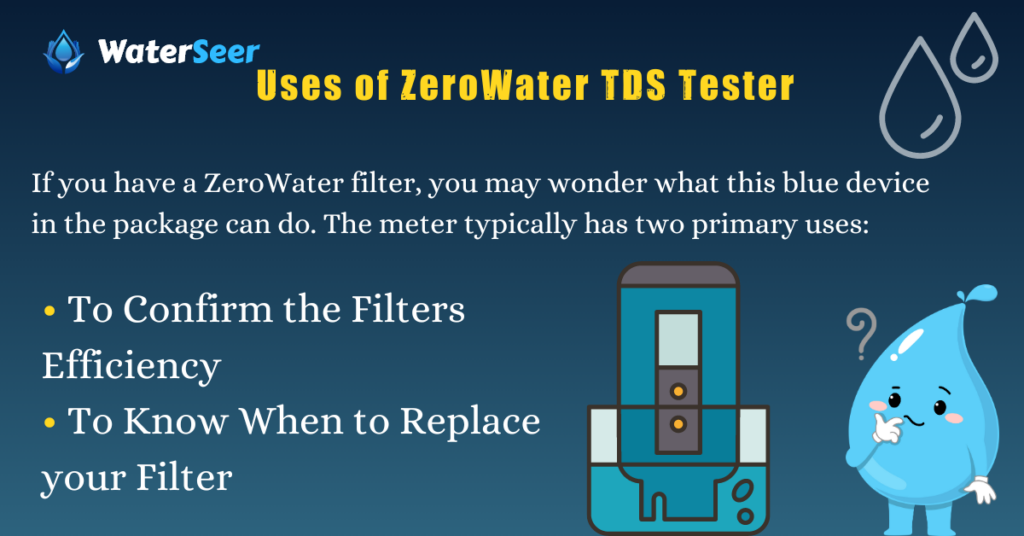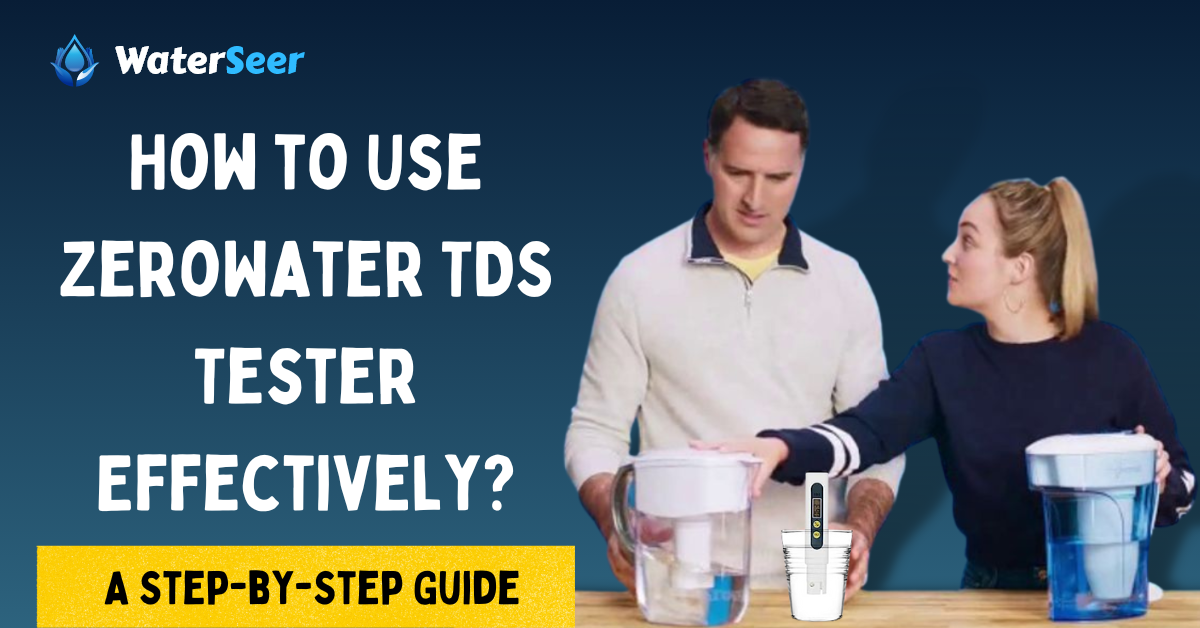Impurities like dissolved solids in water can be challenging to get rid of due to the drastically changing features of its organic pollutants. TDS often makes water unpleasant from taste to look, ensuring you prioritize removal. However, only a few water filters can effectively remove TDS.
Considering the low number of filters with a high TDS removal rate, it is surprising to see many manufacturers add these impurities to the list of what their filters can remove. It can be confusing as you need help identifying which filters exaggerate.
To curb the massive confusion about TDS removal in the industry, Zerowater advertised its filter as turning TDS quantity to zero and has added a tester to prove it. This bold and audacious move shows manufacturers’ trust in the ZeroWater filter. Despite the TDS meter being easy to use, many users may need help understanding its working. Hence, we’re discussing how to use a ZeroWater TDS meter.
What are Total Dissolved Solids (TDS)?
Total Dissolved Solids (TDS) measure all the dissolved organic and inorganic materials. Note that they can be found in various forms like molecular and ionized, albeit all classified as TDS. TDS is measured in parts per million (ppm) and sometimes milligrams per liter (mg/L).
These substances can be metals, salts, ions, or minerals, all from natural sources and human activities. Chemicals and heavy metals often enter the water through human activity, while microorganisms and minerals can enter naturally. A high TDS score indicates a high level of dissolved solids in your water, and it can cause problems ranging from mild discomfort to severe illnesses.
Why do You Need to Remove TDS?
Small quantities of TDS in water are often unproblematic as they contain helpful minerals. However, removing these impurities becomes paramount when its level rises significantly, with more hazardous minerals like lead contaminating your water. There is no standard TDS level, so the suitable amount in your water varies.
Health issues like kidney stones, diabetes, and many heart problems are common effects of prolonged exposure to high TDS levels in water. Other milder problems include the hazy watercolor, pungent smell, or metallic and acidic taste.
What is a TDS Tester?
A TDS tester is a digital device that measures the amount of dissolved solids in your water. It is compact and easy to move, helping you monitor your water anywhere you want to. It is called a TDS meter and features a small screen displaying the result. ZeroWater includes this device in their filter package to help users ensure their efficiency over time.
Instead of relying on ZeroWater’s 99% TDS claim, you can use the TDS tester in their filter to confirm such numbers. This is what makes ZeroWater’s offer impressive. This meter is super easy to use and can provide accurate readings in a few minutes.
Remember, TDS meters only test for dissolved solids in water and cannot determine if water is generally safe to drink. It measures the conductivity of the water but cannot pick up uncharged substances like herbicides and motor oil. Since it cannot differentiate between two ions, these testers can fail to read high concentrations of certain elements in water. ZeroWater TDS tester measures the total dissolved solids and does not differentiate between each type. It is essential to note this as you cannot tell which dissolved solids are spiking your readings.
Step-by-Step on How to Use a ZeroWater TDS Meter

You’ll get an accompanying TDS meter if you buy a ZeroWater pitcher or dispenser filter. You can identify the effectiveness of your ZeroWater filter in removing TDS from the water by performing a before and after check of the water. Thankfully, this takes less than a minute and only requires prior experience to understand.
Step One: Rinse the Canister and Fill With Water
To avoid introducing further contaminants into the water, rinse the canister or jug thoroughly with clean water. After a few rinses, pour filtered water into the container till it almost reaches the brim.
Step Two: Take Off the Cap
There are two caps on the TDS meter, each on both ends. The top cap contains the batteries, while the lower cap hides the testing receiver. For this step, you want to remove the lower-end cap to expose the receiver.
Step Three: Turn On and Submerge
If you look at the TDS meter’s front side, you’ll find two buttons, a start, and a hold button. Press the start button and submerge only the part hidden by the cap you removed earlier. While holding the tester vertically in the water, gently roll the submerged part around to allow the water to go around the receiver and improve the quality of the result. After a few seconds, a reading will appear on the small digital screen.
Step Four: Freeze the Reading and Remove
Once the reading appears on the meter’s screen, press the hold button on the front side to freeze the numbers. Remove the TDS meter from the water and check the reading. It is vital to tap the hold button before removing the meter from the water as the figures can change on exposure to air.
Uses of ZeroWater TDS Tester

If you have a ZeroWater filter, you may wonder what this blue device in the package can do. The meter typically has two primary uses:
1. To Confirm the Filters Efficiency
Since ZeroWater claims to have a 99% TDS removal efficiency, what better way to confirm this figure than with a TDS meter? A significantly reduced reading proves that the filter is adequate.
2. To Know When to Replace your Filter
After its usage period, you can determine the best time to replace your ZeroWater filter. While ZeroWater sets a 25 to 40 gallons or two to five months usage period, these figures are a wide range and not specific. The meter can show you a particular time to change the filter. Changing your filter when your TDS readings rise to 006 is best. You’ll notice a steady increase in TDS level as the filter tires out, so at 006, it is ready to be replaced.
FAQ’s
This section will answer questions that have proven quite popular among ZeroWater TDS enthusiasts. With this, you can better understand what this meter can do.
How to change a TDS meter battery?
Remove the top end cap and replace the two batteries with two new model LR44 batteries while ensuring the two positive sides are facing left. Cover the lid and turn on the meter.
Why is my ZeroWater tester not working?
It can be due to various reasons like faulty batteries and improper storage. The tester should be stored at room temperature as extreme cold or heat can affect it. To fix the problem, turn on the meter and remove the cap while you leave it in the air at room temperature for some minutes. If this doesn’t work, try replacing the batteries.
How to know when to replace the ZeroWater filter?
The best indicator that your ZeroWater requires replacing is when the TDS meter readings rise to 006 from a significantly lower figure. A taste, color, and water order change indicates you should change the filter.
How do I reset my ZeroWater meter?
Press the hold button again to unlock the readings and reset it. You can reset it by restarting the meter and using the off/on knob. While the ZeroWater tester should reset automatically, this may only sometimes be the case, especially when you’ve locked the readings.
Conclusion
A TDS meter effectively measures the total dissolved solids in your water. However, it cannot differentiate between individual elements nor pick up uncharged substances in the water. If you’re looking for a quick way to determine the efficiency and to know when to replace the ZeroWater, using the TDS tester included in the filter package is recommended.

